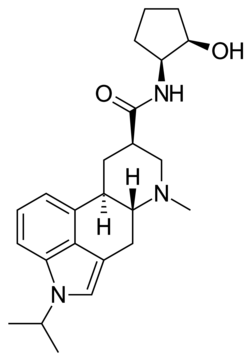Related Research Articles

5-HT receptors, 5-hydroxytryptamine receptors, or serotonin receptors, are a group of G protein-coupled receptor and ligand-gated ion channels found in the central and peripheral nervous systems. They mediate both excitatory and inhibitory neurotransmission. The serotonin receptors are activated by the neurotransmitter serotonin, which acts as their natural ligand.

Pindolol, sold under the brand name Visken among others, is a nonselective beta blocker which is used in the treatment of hypertension. It is also an antagonist of the serotonin 5-HT1A receptor, preferentially blocking inhibitory 5-HT1A autoreceptors, and has been researched as an add-on therapy to selective serotonin reuptake inhibitors (SSRIs) in the treatment of depression.

Methysergide, sold under the brand names Deseril and Sansert, is a monoaminergic medication of the ergoline and lysergamide groups which is used in the prophylaxis and treatment of migraine and cluster headaches. It has been withdrawn from the market in the United States and Canada due to adverse effects. It is taken by mouth.

The 5-HT2A receptor is a subtype of the 5-HT2 receptor that belongs to the serotonin receptor family and is a G protein-coupled receptor (GPCR). The 5-HT2A receptor is a cell surface receptor, but has several intracellular locations. 5-HT is short for 5-hydroxy-tryptamine or serotonin. This is the main excitatory receptor subtype among the GPCRs for serotonin, although 5-HT2A may also have an inhibitory effect on certain areas such as the visual cortex and the orbitofrontal cortex. This receptor was first noted for its importance as a target of serotonergic psychedelic drugs such as LSD and psilocybin mushrooms. Later it came back to prominence because it was also found to be mediating, at least partly, the action of many antipsychotic drugs, especially the atypical ones.
The 5-HT3 receptor belongs to the Cys-loop superfamily of ligand-gated ion channels (LGICs) and therefore differs structurally and functionally from all other 5-HT receptors (5-hydroxytryptamine, or serotonin receptors) which are G protein-coupled receptors. This ion channel is cation-selective and mediates neuronal depolarization and excitation within the central and peripheral nervous systems.

5-Methoxytryptamine (5-MT), also known as mexamine, is a tryptamine derivative closely related to the neurotransmitters serotonin and melatonin. 5-MT has been shown to occur naturally in the body in low levels. It is biosynthesized via the deacetylation of melatonin in the pineal gland.

The 5-HT2C receptor is a subtype of 5-HT receptor that binds the endogenous neurotransmitter serotonin (5-hydroxytryptamine, 5-HT). It is a G protein-coupled receptor (GPCR) that is coupled to Gq/G11 and mediates excitatory neurotransmission. HTR2C denotes the human gene encoding for the receptor, that in humans is located at the X chromosome. As males have one copy of the gene and in females one of the two copies of the gene is repressed, polymorphisms at this receptor can affect the two sexes to differing extent.

5-Hydroxytryptamine receptor 4 is a protein that in humans is encoded by the HTR4 gene.
The 5-HT1 receptors are a subfamily of the 5-HT serotonin receptors that bind to the endogenous neurotransmitter serotonin (also known as 5-hydroxytryptamine, or 5-HT). The 5-HT1 subfamily consists of five G protein-coupled receptors (GPCRs) that are coupled to Gi/Go and mediate inhibitory neurotransmission, including 5-HT1A, 5-HT1B, 5-HT1D, 5-HT1E, and 5-HT1F. There is no 5-HT1C receptor, as it was reclassified as the 5-HT2C receptor. For more information, please see the respective main articles of the individual subtypes:

5-hydroxytryptamine receptor 1B also known as the 5-HT1B receptor is a protein that in humans is encoded by the HTR1B gene. The 5-HT1B receptor is a 5-HT receptor subtype.

5-hydroxytryptamine (serotonin) receptor 1D, also known as HTR1D, is a 5-HT receptor, but also denotes the human gene encoding it. 5-HT1D acts on the central nervous system, and affects locomotion and anxiety. It also induces vasoconstriction in the brain.

8-OH-DPAT is a research chemical of the aminotetralin chemical class which was developed in the 1980s and has been widely used to study the function of the 5-HT1A receptor. It was one of the first major 5-HT1A receptor full agonists to be discovered.

5-hydroxytryptamine (serotonin) 1E receptor (5-HT1E) is a highly expressed human G-protein coupled receptor that belongs to the 5-HT1 receptor family. The human gene is denoted as HTR1E.

5-hydroxytryptamine (serotonin) receptor 1F, also known as HTR1F is a 5-HT1 receptor protein and also denotes the human gene encoding it.

5-Hydroxytryptamine receptor 2B (5-HT2B) also known as serotonin receptor 2B is a protein that in humans is encoded by the HTR2B gene. 5-HT2B is a member of the 5-HT2 receptor family that binds the neurotransmitter serotonin (5-hydroxytryptamine, 5-HT).

5-Hydroxytryptamine (serotonin) receptor 5A, also known as HTR5A, is a protein that in humans is encoded by the HTR5A gene. Agonists and antagonists for 5-HT receptors, as well as serotonin uptake inhibitors, present promnesic (memory-promoting) and/or anti-amnesic effects under different conditions, and 5-HT receptors are also associated with neural changes.

The 5-HT7 receptor is a member of the GPCR superfamily of cell surface receptors and is activated by the neurotransmitter serotonin (5-hydroxytryptamine, 5-HT) The 5-HT7 receptor is coupled to Gs (stimulates the production of the intracellular signaling molecule cAMP) and is expressed in a variety of human tissues, particularly in the brain, the gastrointestinal tract, and in various blood vessels. This receptor has been a drug development target for the treatment of several clinical disorders. The 5-HT7 receptor is encoded by the HTR7 gene, which in humans is transcribed into 3 different splice variants.

5-Carboxamidotryptamine (5-CT) is a tryptamine derivative closely related to the neurotransmitter serotonin.

SB-204741 is a drug which acts as a potent and selective antagonist at the serotonin 5-HT2B receptor, with around 135x selectivity over the closely related 5-HT2C receptor, and even higher over the 5-HT2A receptor and other targets. It is used in scientific research for investigating the functions of the 5-HT2B receptor.

LY-215,840 is an ergoline derivative drug developed by Eli Lilly, which acts as a potent and selective antagonist at the serotonin 5-HT2 and 5-HT7 receptors. It has anti-hypertensive and muscle relaxant effects in animal studies.
References
- ↑ Hoyer D, Clarke DE, Fozard JR, Hartig PR, Martin GR, Mylecharane EJ, Saxena PR, Humphrey PP (1994). "International Union of Pharmacology classification of receptors for 5-hydroxytryptamine (Serotonin)". Pharmacol. Rev. 46 (2): 157–203. PMID 7938165.
- ↑ Eison AS, Mullins UL (1996). "Regulation of central 5-HT2A receptors: a review of in vivo studies". Behavioural Brain Research. 73 (1–2): 177–81. doi:10.1016/0166-4328(96)00092-7. PMID 8788498.